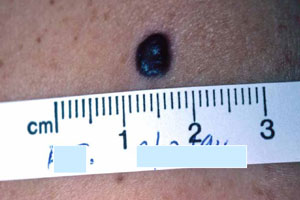IMPROVING clinician awareness of nodular melanoma is the best way to reduce overall skin cancer deaths in Australia, according to a melanoma expert.
Associate Professor John Kelly, head of the Victorian Melanoma Service at the Alfred Hospital, said there was still a lot of ignorance about the characteristics of nodular melanomas.
New research, published in Archives of Dermatology, has found that nodular melanomas account for a disproportionate fraction of fatal melanoma cases. Although they comprise only 14% of all melanomas, they account for 37% of fatal melanomas. (1)
The US research, which analysed data from 1978 to 2007 on 111 478 patients with invasive melanoma, found that survival from superficial spreading melanoma had increased over the study period, but survival from nodular melanoma had not.
“Public health efforts should include a focus on nodular melanoma for maximum reduction of melanoma mortality”, the authors wrote.
Dr Kelly said the research was “really important” and accorded with recent unpublished research he had undertaken on nodular melanomas, and his own clinical experience.
“It touches on the major issue in reducing death rates from melanoma in Australia … Doctors need to be aware that nodular melanomas are a major source of mortality, and we can reduce that mortality if we are aware.”
He said there was a “big job to do” in educating the medical profession about the characteristics of nodular melanomas, although he said there had been increased awareness in recent years.
“Of our options to reduce death rates from skin cancer, this is the best”, he said.
Dr Kelly said that, unlike typical melanomas, nodular melanomas were usually red, symmetrical and had an even border. Therefore, they were often missed with the ABCD criteria (asymmetry, border irregularity, colour variegation, diameter > 6 mm).
He said the EFG criteria (elevation, firm, growing) were more useful for nodular melanomas. It was particularly important to look for a progressive, rapid growth rate.
“Nodular melanomas are not unremarkable, but they present to doctors in a completely different way to more common melanomas.”
He said these melanomas were often confused with other red bumps and misdiagnosed as squamous cell carcinomas, basal cell carcinomas or even pimples, which meant they were not treated with the urgency required. Doctors often didn’t realise the lesion was a cancer until it began growing rapidly, and it was usually not identified until a pathology report was received.
Nodular melanomas grow at about five times the rate of other melanomas, which means there is a short window of opportunity in which to provide effective treatment.
“The story we hear over and over again is that the patient develops one of these lesions, and they get reassured by their doctor”, Dr Kelly said.
He said the main weakness of the US study was the high rate of melanomas that were “not otherwise specified” as a particular subtype.
Pictures and information about nodular melanomas are available on the Victorian Melanoma Service website.
– Sophie McNamara
1. Arch Dermatol 2011; 19 September (online)
Posted 26 Spetember 2011

 more_vert
more_vert